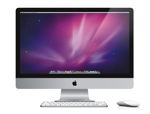Or maybe you don’t own a computer at all but have finally decided to join the digital age.
Either way, a trip to the computer shop is required, be it on the high
street or online. But that can be a pretty daunting prospect – how do
you decide from such a dizzying array of choices? This guide will help
you through the confusion.
Follow these step-by-step instructions on how to choose a computer
Step 1: Work out whether you want a desktop computer or a laptop.
If you’ll be using it in one place, a desktop will be cheaper and
easier to modify, but laptops have the obvious benefits of mobility and
smaller size. If you opt for the latter, check out our article Which laptop?
Step 2: Decide whether you want a PC or a Mac. There are some obvious and some subtle differences between them – have a look at our more detailed articles on What is a PC? and What is a Mac?).
But in general, PCs are harder to use but are cheaper and have more
software, and Macs are easier to operate but are more expensive and less
software has been created for them.
Step 3: Probably the most important step of all: figure out how much money
you’re willing to spend. Computers vary hugely in price and it’s easy
to spend far more than you intend. You want to get as powerful a
computer as possible for your cash, but you probably don’t want to go
overboard.
Very basic PCs can cost below £200, but these are usually specialist
models. Most mid-range PCs will set you back between £200 and £500, with
high-end machines much more than that.
 An Apple iMac (left)
ranges in price from £899 to £1,999, depending on how powerful you want
it to be and how big a screen you prefer. But an iMac is an ‘all in
one’ – that is, it’s a computer and screen combined, so you don’t have
to pay separately for the latter.
An Apple iMac (left)
ranges in price from £899 to £1,999, depending on how powerful you want
it to be and how big a screen you prefer. But an iMac is an ‘all in
one’ – that is, it’s a computer and screen combined, so you don’t have
to pay separately for the latter.
Step 4: Do you need to buy a screen?
Also known as ‘monitors’, these can cost almost as much as a PC itself,
so if you’ve already got a reasonable one, you might want to save money
by sticking with it. Watch out, though – older monitors may not have the
modern connectors that newer computers use.
If you do decide to get a screen, buy as big a one as you can afford –
the difference in your productivity and the sheer enjoyment you’ll get
just using your computer will make it worth your while.
Step 5: Decide how powerful a computer
you need. If you’re planning on using it only for word processing and
browsing the web, you can probably get by with a relatively less
powerful machine. But if you’re doing some fancy image or video
manipulation or want to play the latest games at their best, you’ll need
a computer with a lot more heft. More power costs more money, but
remember: the more powerful a computer is, the longer it will last
before it needs to be replaced.
Step 6: You’ll have to settle on how big a hard drive
you need. Hard drives are where the information on your computer is
stored, and the more information you have, the bigger you’ll want to
your hard drive to be.
Text files take up a tiny amount of space, so if that’s all you’re
keeping, you’ll need hardly any space at all. However, if you’re keeping
a large music, photo or video library, you’ll see that space filling up
quickly, and if you’re doing video editing, you’ll need a very large
hard drive indeed.
Tidak ada komentar:
Posting Komentar